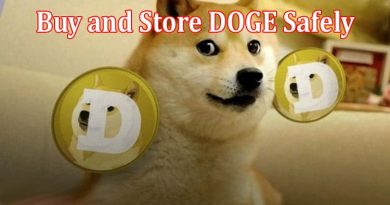4 Tips for Trading Ethereum In 2023
Perhaps the most significant difference between trading Ethereum and purchasing it is that trading can be conducted for a short or long period of time, depending on your outlook. If you buy Ethereum outright, you must take into account the ups and downs of the price, jumping through several hoops. Owning just one token can turn out to be expensive; it all depends on the ETH price. If you’re just getting the hang of trading, you might be tempted to copy the moves of high-profile traders, and it can come back to bite you. Use caution. If you’re planning on turning a profit from Ethereum, these strategies will help you trade successfully.
1: Understand What Impacts Ethereum Price Movements
Ethereum is known for its volatility. The ETH price can fluctuate considerably over short periods, and the significance of the impacts (shocks) is still being analyzed and debated. The ability to assess price movements is crucial in trading. The cryptocurrency market tends to correlate with Bitcoin, so Ethereum’s value is often measured against the price of Bitcoin, rising or dropping at the same time. This is trivial when it comes to smaller transactions, but such dependence can cause issues if you carry out bigger transactions. In a market with increasing volume and price pressure, the right approach is of the essence.
Ethereum’s price is affected by supply and demand, meaning that when supply decreases and demand increases, its price will rise. Conversely, when supply increases and demand decreases, the price of Ethereum will fall. At present, there are roughly 121.826.163,06 ETH in circulation. The supply relies on two forces, namely issuance (the process of creating ETH) and burn (when ETH is removed from circulation). The demand can be measured by examining the ecosystem metrics and the number of active addresses that hold Ethereum, not to mention the number of transactions that occur. Following the Merge, it’s expected that the higher staking yield, deflationary supply, and increased scalability will drive demand.
2: Become A Successful Trader Starting Small
It’s not a good idea to use all your money to invest in Ethereum, so spend only money that you don’t need. It can be any amount you’re comfortable with. In case you didn’t already know, you can start trading with as little as $10 to minimize the amount of risk you take for your account. The amount of money you can make isn’t very much, but it will prove your point. Once you gain more experience, you can gradually increase your investments. Buying both Ethereum and Bitcoin is a solid strategy if you’re interested in diversifying your portfolio. Safeguarding your bottom line in a volatile market requires effective risk management, and while diversification can lower risk, it can’t completely eliminate it.
3: Learn The Commonly Used Ways for Trading Ethereum
Without a well-planned strategy, you leave yourself open to the cryptocurrency market and your emotions. Understand what type of trader you are, your time frame of trading, and the token you’re trading. When it comes down to trading Ethereum, whether on a brokerage or exchange website, the following tactics are the most commonly used:
- CFDs. CFDs allow you to speculate on the price of Ethereum. To trade Ethereum’s tokens, you need a wallet, which can take several days to acquire, but when you trade CFDs, you don’t actually own the coins, so all you need is a trading account. It enables you to trade in a quicker and more convenient manner.
- Futures. Futures are financial derivative contracts for assets bought at an agreed price but delivered and paid for later. If your prediction is correct, you make a profit; otherwise, you support the consequences. ETH futures or other crypto derivatives offer an efficient way to manage your exposure to one of the biggest cryptocurrencies by market share.
- Options. Options trading gives you the right to buy and sell Ethereum on a specific date at a specific price. It’s similar to a futures contract, the only difference being that you don’t have to close on your position on settlement day. ETH call options allow you to buy tokens at a fixed price, while ETH put options allow you to sell your assets at a set price within a given time frame.
A trading plan is to Ethereum trading what a business plan is to a business. Risk is ever-present in the cryptocurrency market, so how you enter and exit trades is of the essence.
4: Take Into Account the Upcoming Ethereum Shanghai Upgrade
As you probably know, an important upgrade is on the way, namely the Shanghai Upgrade (EIP-4895) on the Sepolia test net. One of the most significant developments is that it will allow stakers and validators to withdraw assets from the Beacon Chain, not to mention the rewards earned until the update. Validators have been staking ETH since December 2020. According to some analysts, it’s unlikely they’ll recover their staked tokens on account of Ethereum’s dominance in the decentralized finance space. At any rate, those who want to pull ETH out from the system can create a withdrawal credential or exit the Beacon Chain entirely.
Much work has gone into improving the Ethereum blockchain and ecosystem; it will be mirrored in its price sooner or later. Staking is a key aspect concerning the movement of ETH price, so following the Shanghai network upgrade, users will, in all probability, want to HODL and stake Ethereum as adoption increases. If this is the case, the ETH price will rise as prodigious institutions buy and stake tokens. Of course, inflation might determine stakers and validators to sell their coins to gain more liquidity so the rest of their portfolio can stay afloat.
To sum up, Ethereum is a remarkable cryptographic achievement, so if trading is in your mind, this coin is your best bet. As with any investment, take lessons on managing risk and devise a strategy to trade wisely in this pool of opportunities. Once you’re aware of the mistakes, trading pitfalls can be easily avoided.




